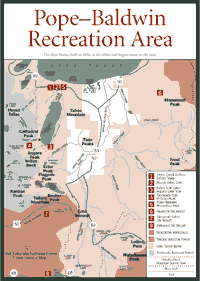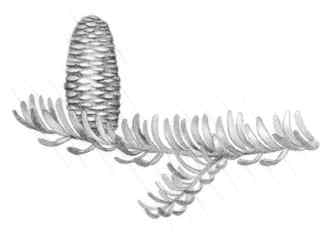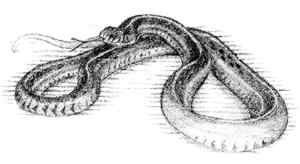 Pope-Baldwin
Recreation Area
Pope-Baldwin
Recreation AreaA lot of people visit South Shore to enjoy the interesting combination of camping, boating, hiking, touring, and gambling. With large casinos, such as Harrah's, just across the state line in the city of South Lake Tahoe, outdoor recreation can be the second choice for some people.
Out on the lake, not more than 0.5 mile from the casinos, people boat, enjoy the sunshine, and swim. A little farther away from the bright lights, such places as the Pope-Baldwin Recreation Area beckon visitors to hike and visit historic sites. Tallac Historic Trail takes visitors to the beach and to self-guided tours of homes dating back to the early part of the century. Other trails lead to such wonders as Mount Tallac, the 9,735-foot peak visible from all parts of the South Shore. Tallac stands so close to the lake that hikers can actually see the currents moving. Tributaries adding water, wind blowing across the surface, and other factors create currents.
The migrating birds are exceptional at sites on the South Shore, as they are in many places around Lake Tahoe. Fishing, camping, and boating are all part of the attraction, though it can get a little crowded in August during the height of the tourist season. Snow skiing and snowplay are among the major reasons to visit the South Shore. Skiers can find about a half-dozen cross-country courses and several downhill locations. Snowmobiling and ice skating are part of the winter recreation on the South Shore.
In the South Shore area, the bedrock is like that in the rest of the basin, composed of a type of granite rock called granodiorite and a type of volcanic rock called andesite. The volcanic soils tend to hold more nutrients. The volcanic rock breaks down easier than granite, contains more clay, and makes a good place for plants to grow. The vegetation and wildlife are not hard to find on trails to the surrounding peaks. Freel Peak, at 10,881 feet, is the tallest and affords the most panoramic views of the lake and the Sierra. Echo Peak, at 8,895 feet, is less spectacular, but it is much closer to the lake than Freel and offers special views of nearby drainages into Tahoe.
 Pope-Baldwin
Recreation Area
Pope-Baldwin
Recreation Area[Fig. 32(5)] Cultural history is almost everywhere for visitors to find in the recreation area. The Tallac Resort, the Pope Estate, and the Baldwin Estate are prime examples, but they are not the only attractions.
The natural features get a lot of attention from visitors, too. Though large animals are not common here, as they are in the wilderness and backcountry areas, there are squirrels burrowing under trees, water frogs, snakes, crayfish, and many species of birds.
Common California gray squirrels (Sciurus griseus) can be seen scampering in search of food. Don't feed them. Animals such as squirrels can become dependent on human food and abandon their natural foraging.
In the case of the gray squirrel, food and shelter come from the surrounding trees. Pine seeds and oak acorns are the usual fare. The squirrel has no cheek pouches, so it must eat whatever it finds instead of holding some food in its cheeks.
The gray squirrel nests high in pine trees, unlike the golden-mantled ground squirrel (Citellus lateralis), which burrows beneath pine trees, such as the lodgepole pine. Visitors probably will encounter golden-mantled ground squirrels because most of them have little trouble approaching humans. They will rummage through campgrounds for food, even eating from the hand of a camper.
In the natural order of things, the squirrels are generally targets for the long-tailed weasel (Mustela frenata), mountain coyote (Canis latrans), and hawks of many species. The struggle for life among predators and prey sometimes continues almost unnoticed on South Shore because people can become preoccupied with the cultural and recreation attractions, especially along the flat, 2-mile Tallac Historic Site Trail. The trail begins at the Taylor Creek Visitors Center in the Pope-Baldwin Recreation Area.
A number of turn-of-the-century estates and an old resort site are within walking distance of each other at the Tallac Historic Site. They are on a 74-acre site that was transferred to the U.S. Forest Service about 30 years ago. Many of the buildings needed to be restored to give visitors a good idea of how wealthy Northern Californians vacationed in the past.
The Tallac Resort, dating back to 1890, is where the "Greatest Casino in America" once stood at Tallac Point. It was part of a resort owned by San Francisco real estate businessman Lucky Baldwin. Not much of the resort is left to see these days.
But the Pope Estate, built in 1894 by a prominent San Francisco Bay area family, is nearby, and it is intact. It is the oldest and largest estate in the area. Special programs and guided tours are available in the many buildings, gardens, and grounds. Each year in August, The Pope Estate is home for The Great Gatsby Festival, where people dress in early-twentieth century attire and celebrate. People can walk from the estate to Pope Beach, which is less than 100 yards away.
The Baldwin Estate dates back to 1921. It was the home of Lucky's granddaughter. Now it is the Baldwin Museum. The exhibits include Washoe Indian culture, Baldwin history, and the Baldwin House itself. The Heller Estate, built in 1923, is also known as Valhalla. It has a large lawn, hall, and fireplace, and is popular for public and private gatherings.
 Taylor
creek Visitors Center Trails
Taylor
creek Visitors Center Trails [Fig. 32(1)] Interpretive trails have been constructed around the U.S. Forest Service's Taylor Creek Visitors Center to tell people about the natural history. They include the 1-mile Lake of the Sky Trail, the 0.6-mile Rainbow Trail, the 0.1-mile Smokey's Trail and the 0.2-mile Forest Tree Trail. A fifth trail, the Tallac Historic Site Trail, goes to the historic estates and sites around the area. It is about 2 miles long.
On the Lake of the Sky Trail, look and listen for the many pileated woodpeckers (Dryocopus pileatus) as they hunt through the trees for bugs, which could actually be destructive to the trees. Various kinds of bark beetles, such as the western pine beetle (Dendroctonus brevicomis), burrow into pinewood to deposit larvae that emerge the next spring. The bark beetles are extremely destructive if they grow to epidemic infestations. Many acres of trees have been felled to clean out infestations that have occurred periodically during the twentieth century in the South Shore and many other places in the Sierra.
On the 0.5-mile Rainbow Trail, stop at the boardwalk and on the viewing bridge over Taylor Creek to observe the water world: fish of all sizes; insects under, on, and above the water; frogs. Common garter snakes (Thamnophis sirtalis) are in this area. They are up to 4 feet long and harmless. Look for them near or in the water. Kokanee salmon (Oncorhynchus nerka) spawn in Taylor Creek before returning to Lake Tahoe to live.
At the end of the Rainbow Trail, there is a Stream Profile Chamber that allows 300,000 people annually to view the stream environment through aquarium-like windows built on a diversion of Taylor Creek. The chamber features floor-to-ceiling viewing windows, about 12 feet of viewing, and a 180-degree curved diorama along with interactive interpretive components.
 Mount
Tallac Trail
Mount
Tallac Trail [Fig. 32(2)] Mount Tallac is a magnet for hikers who want to get above 9,000 feet and stay close to Lake Tahoe. The views of the glacial moraines are stunning. The rocky borders where glaciers melted and dropped granite boulders outline Emerald Bay, Fallen Leaf Lake, and other landmarks.
Near Floating Island Lake, note the grass of Parnassus (Parnassia fimbriata) that lines the water's edge in a few damp, shady areas. Look for the large white flower. Also, look for the black fruit of the Sierra coffeeberry (Rhamus rubra). It looks like a coffee bean, but this isn't something hikers will want in their coffee cup. It is not edible.
Floating Island Lake is named for large mats of bentgrass (Agrostis), brewer's reedgrass (Calamagrostis breweri), and various shrubs that seem to be floating in the shallow lake. As early as 1890, the lake was noted for its floating mats of vegetation.
At the summit of Tallac, hikers will see some interesting wildflowers in July and August. The flowers must maintain most of their growth below ground to protect themselves from the cold winds whipping over the mountaintop. Such flowers include the dwarf alpine daisy (Erigeron pygmaeus), hairy paintbrush (Castilleja pilosa), and butterballs (Eriogonum ovalifolium). These plants must adapt to the colder, harsher conditions on ridgetops by simply growing lower and staying closer to their source of food.
[Fig. 32(3)] The view of Lake Tahoe and Fallen Leaf Lake are wonderful on this hike. Stands of white fir line the trail. As hikers move higher in elevation the smell of tobacco brush (Ceanothus velutinus var. velutinus) greets them along with the distinctive white flowers with yellow stamens.
Swimming is a favorite activity at Angora or Fallen Leaf lakes. Wait until late August or September to take a dip, however. The fresh snowmelt earlier in the season makes the water very cool.
When hikers reach Angora Lake, amid stands of Jeffrey pine bent and stunted because of the wind, they will be almost within view of the Angora Resort, which was built in 1917. Many years ago, children called this place the Lemonade Lake because of the lemonade served at the resort.
[Fig. 32(4)] The Tamarack Trail is a wildflower hike in summer. Microclimates are created by the up-and-down topography that shields small nooks and crannies from the cold north winds. The result is sheltered benches and meadows filled with white thimbleberry (Rubus purviflorus) and purplish blue aconite monkshood (Aconite columbianum).
Birds eat the thimbleberry fruit, the small dark berry. But animals and people alike do well to avoid eating any part of the monkshood, which contains an alkaloid called anconitine. One bite of this stuff and people start experiencing nausea and impaired vision, a bad combination on any high Sierra trek.
The hike also takes people past deep history in the granite. Metamorphic rock from a time well before the main Sierra uplift—perhaps 120 million years ago—can be seen with intrusions of younger granite. Look for the features before reaching and crossing Glen Alpine Creek on the Tamarack Trail.
After about 2 miles, hikers will be able to decide if they would like to visit Triangle Lake to the northwest or turn northeast to 8,895-foot Echo Peak. The hike can be reduced by about 1 mile by skipping the lake. Many people prefer to stop at the lake for a dip before turning around and hiking up to Echo Peak, which provides views of the lake and the Desolation Wilderness to the west.
[Fig. 32] People who enjoy hiking the high country and want to see a 360-degree panoramic of Lake Tahoe, parts of Nevada, and even a piece of the Central Sierra should try this trail. It is a chance to see high-elevation wonders without the crowds. Though it requires a fit, strong hiker to make this day trip, it is well worth the work.
The Tahoe Rim Trail will take hikers close enough to make the 1-mile, 1,100-foot cross-country scramble to the summit. People leave the rim trail at its highest point, 9,728 feet, for the cross-country jaunt. Granite pinnacles and volcanic ridges are everywhere in view, including Mount Tallac to the northwest of the trail.
For wildflower lovers, the hike is a treat in July and August. The blue, bell-shaped flowers of Jacob's ladder (Polemonium californicum) are likely to be seen in this area, especially in the open forest below 9,000 feet as the hike begins. The stems have ladder-like leaves with several hairless lancelate leaflets.
The diamond clarkia (Clarkia rhomboidea) is a rare species in Tahoe, having been first cataloged near Fallen Leaf Lake on the South Shore many years ago. Now, the diamond-shaped petals can be seen only in dryer areas at the beginning of this hike. The genus is named for William Clark of the nineteenth century Lewis and Clark expedition.
Look for the dwarf alpine aster (Aster alpigenus), the lavender flower that grows on the borders of meadows in September when other wildflowers have already faded. The deep purple flowers are the meadow penstemon (Penstemon rydlbergii), which also grow in drying meadows.
The aster and the penstemon, as well as shrubs along this trail, adapt well to the thin, rocky soils. The plants use tap roots and dwarf characteristics—such as growing low to the ground—to survive.
Some plants adapt even to small cracks in the granite, created by freezing and thawing over time. Such hardy vegetation includes the alpine fescue (Festuca brachyphylla), draba (Draba densfolia), and alpine locoweed (Astragalus kentrophyta). These plants can survive under snow cover during the winter, but they also can survive in extremely windy, dry conditions.
Not many large animals go above the tree line, which hikers will notice is at about 9,000 feet on this hike. The trees simply stop growing because the soil, elevation, sunlight, and other factors make it impossible for larger trees to survive. Hikers will notice some animals, such as the heather vole (Phenacomys intermedius) and the gray-crowned rosy finch (Leucosticte tephrocotis). The finch forages for seeds in summer above 9,500 feet.
The frequent freezes and thaws at these elevations also create interesting geology. The bedrock along the slope to Freel Peak is littered with quartz and feldspar crystals. But most first-time hikers on this trail will be looking for a stable place to walk or stand so they can take in the views from the rooftop of Lake Tahoe.
The South Shore skiing, featuring some of the best skiing anywhere, is home to three major resorts, many cross-country skiing courses, and a long snow season. Sometimes the skiing goes all the way through June, particularly if the El Nino weather pattern has sent a lot of storms from the Pacific Ocean.
The history of skiing runs deep at Lake Tahoe, especially at the South Shore. Prior to the 1950s, skiers in the South Shore went to Echo Summit. Early in the century in Truckee near the North Shore, there was a winter carnival with skiing and jumping events. The first chairlifts in the West arrived at Tahoe in the late 1930s.
The Winter Olympics of 1960 put Tahoe's slopes in the spotlight. The downhill events were held at Squaw Valley, near the West Shore but technically in the Tahoe National Forest. People from all over the world began to visit Tahoe in the winter just to ski.
Now, people visit more than a dozen ski areas in the Tahoe area. People ride snowmobiles and sleds. When the weather does not cooperate, people can gamble at the nearby casinos or visit a museum.
For those who prefer cross-country skiing, Tallac Historic Site Trail and the Taylor Creek/Fallen Leaf trail system provide opportunities. The Tallac trail, located in the Pope-Baldwin Recreation Area (see page 158) is flat and well marked. It is perfect for beginners. The Taylor Creek/Fallen Leaf system, found around the Taylor Creek Visitors Center (see page 157), is also mostly flat and easy for beginners.
[Fig. 32(6)] It's not hard to understand why a lot of people ski at Heavenly—more than two dozen chairlifts, 37 feet of snow each year, and about 4,500 acres of skiing over two states. This is one of the larger skiing operations anywhere, and it is in one of the snowiest places in the United States.
Monument Peak rises to more than 10,000 feet on the southeast and the drop is almost 4,000 feet to Heavenly Valley. The resort offers skiing hills for all levels as well as ski lessons.
[Fig. 32(7)] The Sierra-at-Tahoe ski resort, sister of the Northstar-at-Tahoe on the North Shore, offers long runs for skiers of all skill levels. The resort, which was once called Sierra Ski Ranch, has one run that covers 3 miles.
The area has a more modest rise in elevation than Heavenly. It drops from about 8,850 feet to about 6,600 feet, but it has plenty of excitement and variety, according to the experts.
Though Sierra-at-Tahoe is actually in the El Dorado National Forest, it has traditionally been considered a feature of South Shore skiing.
[Fig. 32(8)] Kirkwood gets some of the heaviest snowfall in the Tahoe region. Parts of this area have received more than 50 feet of snow a few times this century. Kirkwood has a reputation for having good snowpacks and long seasons, so skiers flock to this area.
The resort has a four-story lodge and 19 condominiums. People can just ski back to their rooms when they're finished on the slopes. Kirkwood has about 2,000 acres of groomed slopes and runs for people of all skill levels. The highest elevation run starts at 9,825 feet.
Read and add comments about this page